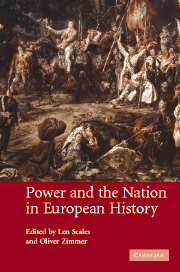Book contents
- Frontmatter
- Contents
- List of contributors
- Introduction
- PART I APPROACHES AND DEBATES
- PART II THE MIDDLE AGES
- PART III ROUTES TO MODERNITY
- 8 The state and Russian national identity
- 9 Ordering the kaleidoscope: the construction of identities in the lands of the Polish-Lithuanian Commonwealth since 1569
- 10 Nationhood at the margin: identity, regionality and the English crown in the seventeenth century
- 11 The nation in the age of revolution
- PART IV MODERNITY
- Index
10 - Nationhood at the margin: identity, regionality and the English crown in the seventeenth century
Published online by Cambridge University Press: 02 December 2009
- Frontmatter
- Contents
- List of contributors
- Introduction
- PART I APPROACHES AND DEBATES
- PART II THE MIDDLE AGES
- PART III ROUTES TO MODERNITY
- 8 The state and Russian national identity
- 9 Ordering the kaleidoscope: the construction of identities in the lands of the Polish-Lithuanian Commonwealth since 1569
- 10 Nationhood at the margin: identity, regionality and the English crown in the seventeenth century
- 11 The nation in the age of revolution
- PART IV MODERNITY
- Index
Summary
There is now little doubt that during the early modern period England saw the development of a precocious statehood. It is some years since Patrick Collinson drew our attention to the covenant which sought to ensure continuity in the regime should Elizabeth perish, and since David Norwood highlighted the elements of republicanism in the aristocratic thought of the early seventeenth century. More recently, Sean Kelsey has argued that the interregnum saw creative and effective developments in the ideology and iconography of English republicanism. For our purposes here, all this is significant, but the context of this manifestation of a close alignment between state, nation and power, more or less independent of monarchy, was the complex one of the multi-ethnic British Isles. This chapter seeks to examine the interaction not of English state and English nation, but of English state and nation with the non-English communities of Britain and beyond.
I will be less concerned with Ireland and Scotland, where there has been significant work already on the interactions between power and nation. Rather I want to look at some of the others in this situation who were in some sense territorially defined. All possessed some ethnic, cultural or jurisdictional distinction from the rest of England, in varying measures. Language and Celtic cultural identities mattered in Wales, in Cornwall and in the Isle of Man; Norman-French language and identity in the Channel Islands.
- Type
- Chapter
- Information
- Power and the Nation in European History , pp. 232 - 247Publisher: Cambridge University PressPrint publication year: 2005

